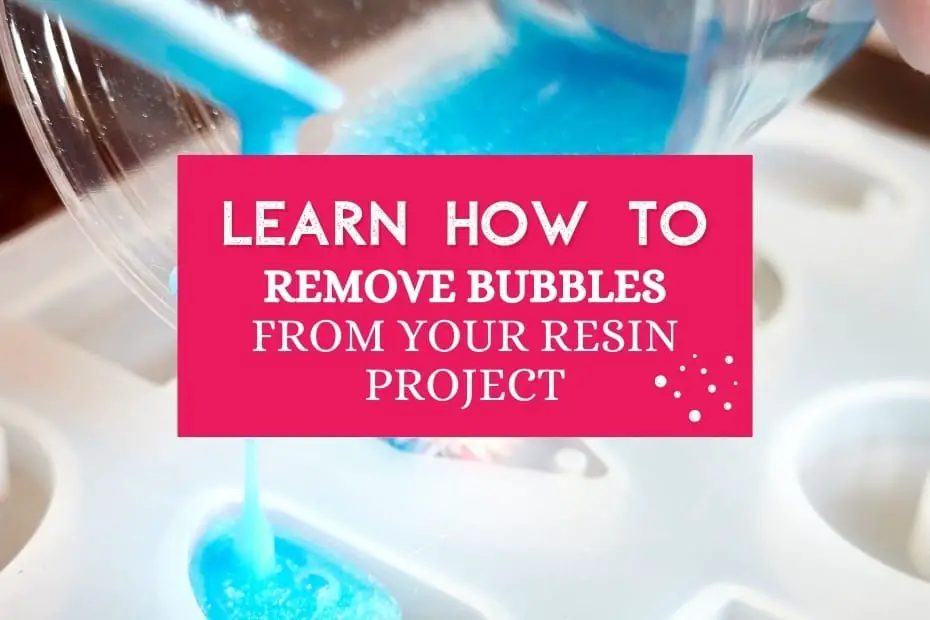Hi everyone! This post is to help answer a common question I get in my inbox from time to time. It is a simple tutorial for those of you who wonder how to remove bubbles from your resin. There is a right way, a wrong way, and a few in-between ways. Let’s get to it!
*As an Amazon Associate this post contains affiliate links for which I may be compensated a small amount if you should click and purchase something through them. This is at no extra cost to you.
Table of Contents
How do pesky bubbles form in resin?
Mixing too fast is the most common reason for resin bubbles to form. Literally hundreds of bubbles will be created from the rapid mixing due to air being forced around.
Next, make note that organic materials store oxygen and release it. This means when you coat leaves, flowers, wood, fabric, and other porous material it can create bubbles long after it has been coated with resin. Sometimes hours later!
Finally, when you coat certain objects you’ve placed in a mold with resin, it can have an air pocket trapped underneath it. A good example is laying a piece of clay in a silicone mold and coating it with resin. Because the clay was placed flat down, there is an area that is not able to be coated with resin. This will create an air pocket and most likely a hole in your resin art.
How can I prevent resin bubbles?
There are several ways to prevent resin bubbles. Let’s discuss each situation and the procedure to correct it so you can create much nicer works of art!
Mixing too fast – Slow down. Stir slowly and deliberately for 3 to 5 minutes to get your resin mixed. Use a straight popsicle stick or reusable silicone stirrer.
Organic material releasing oxygen – The best thing to do is to seal the material before hand. Use a spray on sealant or clear coat to keep air from releasing while your resin cures.
Air pockets under placed objects – I recommend coating any piece you are about to place in resin…with resin! For example if you are wanting to put beautiful pearls in your work of art, stir them around in your cup of resin beforehand.
You can also use a pair of tweezers to dip objects in resin before placing them. This isn’t always viable for everything, but it will keep your object from laying flat and creating a huge air pocket.
Heating tools
Using heat is one of the most effective ways to get rid of bubbles in resin. If you’ve followed the procedure to prevent them from the start along with effective heat tools, you will have the least amount of bubbles in your art.
What heat tool is best?
I will admit this is something I didn’t know when I first started working with resin. Most professionals use a utility lighter to remove resin bubbles in their art work.
Use common sense and good practice if you should choose to use any kind of lighter of course. Flames are dangerous and you should never use flames too close to resin.
BUT! The reason lighters are so effective is because they get much hotter than any other heat tool and can quickly disperse of bubbles. Heat causes resin bubbles to burst almost instantly.
If I ever am to use a lighter rather than my heat gun I would choose the lighter with an extension. I prefer for the flame to be as far from me as possible.
Also many lighters come with a bendable extension which allows you to get better angles. Still keep in mind that resin fumes can be flammable and you could damage your mold if you aren’t careful.
Other Options
I honestly prefer using a heat gun with my resin art and I’ve had excellent luck. It’s a cheap and effective option that is much less dangerous than an actual flame.
Heat guns heat up quickly and disperse of the majority of bubbles. I also like a heat gun because it can blow gently on the surface of the resin which allows other bubbles hiding to rise to the top so they can be popped.
Alternatively, you can use a hair dryer, blow through a straw, or even use a toothpick to pop bubbles you can easily see.
My resin piece has already cured and now it has holes! What do I do?
Take a deep breath. I know it stinks when this happens, but honestly some bubbles just cannot be avoided. However, there is an easy fix!
First, make note of how big the bubble is. Is it a large hole in the piece or lots of little ones.
If you have a large unsightly hole in the piece that compromises it, I would recommend sanding and a top coat.
Often you can sand and add a top coat to a large or small imperfection and it will be hardly noticeable.
Tips for sanding
- Wear A Mask
- Use Wet/Dry Sand Paper
- Start With Course Grit 200-400
- Wet Your Sand Paper
- Move Your Piece Around In Circular/Figure 8 Even Motions
- Gradually Move To A Fine Grit 1000-2000
- Rinse Your Art To Remove Any Dust
- Add A Top Coat If Necessary
Polishing Resin After Sanding To Remove Bubbles
You may notice that after you sand a piece of resin your bubble problems are no more, but you now have a cloudy piece of resin.
This is frustrating for some because they think their resin artwork is ruined.
I highly recommend using a cotton buff with a polishing compound on your piece. You will not believe the amazing shine you can achieve.
My polishing compound of choice is Flitz. One can has lasted me forever. Not only does it shine your resin up nicely it also protects it.
I hope this helps!
Hopefully, this brief tutorial will help you better understand why bubbles form and how to remove them in resin. I do hope your resin projects turn out marvelous. As always feel free to share your work with me at [email protected] for a chance to be featured on the website!
Do check out some of my other resin posts and also feel free to check out my most beloved product recommendations for resin crafts.
Stay happy healthy and crafty!

